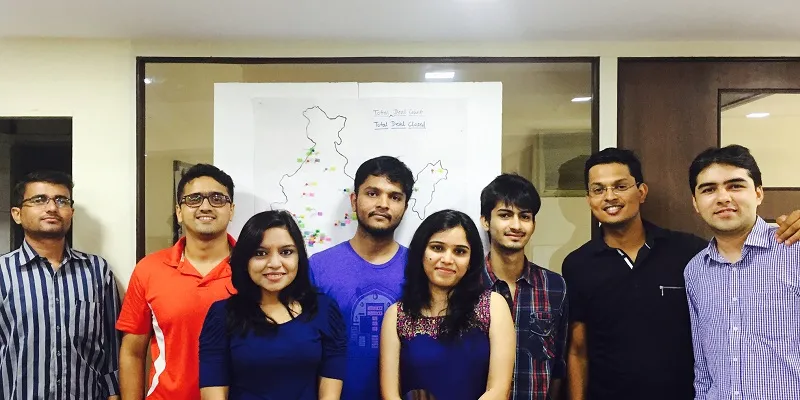How agritech startup Truce is helping farmers have a field day and reaping the benefits
Helping bridge the gap between farm and fork, Mumbai-based Truce is a B2B web and mobile platform that directly connects farmers and suppliers
It is 5am and 35-year-old Shivkumari is on her way from Malur district to Bengaluru’s Agricultural Produce Market Committee (APMC) Yard in Yeshwanthpur. Sitting in a compartment laden with sacks of fruits and vegetables, Shivkumari is thinking of the negotiation battle in store and the crowd she’ll need to face.
In most cases, vegetable and fruit prices are determined by weather conditions, which can cause a surplus or deficit of produce. All the way, Shivkumari can only hope for a decent bargain.
The Bengaluru APMC is where most retailers and distributors buy produce. They take it to their shops and outlets, from where it reaches our kitchens and dining tables. This holds true not just in Bengaluru but in every Indian city.
Problems at the grassroots level
Keeping the problem farmers face in mind, Saurabh Jain and Kedar Gokhale, friends from their IIT Bombay days, worked on probable solutions. The lack of transparency and trust in the farm supply chain set Truce on a mission to restore transparency among buyers and sellers of farm produce.

And since 68 percent of India's population is rural and agriculture is the main source of livelihood for 58 per cent of them, it was imperative to consider the role digital agriculture can play within Digital India.
Saurabh, who has over five years of experience in supply chain analytics, and Kedar, with experience of over five years in operations, agriculture and food chain logistics, launched Truce, a B2B web and app platform that allows farmers to connect directly with wholesalers and retailers.
Over time, the product has evolved to its current model. Initially, Truce worked on a different model. The team at Truce would procure produce from farmers, store it in their warehouses and sell to wholesalers through their online platform. The prices were standardised so farmers and retailers got a fair deal. In a way, they were rivalling the APMC model. But they found the task operationally intensive and difficult to scale.
The prices were standardised so farmers and retailers got a fair deal. In a way, they were rivalling the APMC model. But they found the task operationally intensive and difficult to scale. So they scrapped the APMC-like model to focus on using technology to connect farmers and retailers.
Also read: 2017 may turn out to be the year of agri-tech
Connecting buyers and sellers
The team had realised that farmers didn’t mind the logistics and selling; all they wanted was to directly connect with retailers and get a fair price for their produce.
Truce now works as a connecting platform where sellers showcase their produce at different tech-enabled price bands and buyers/wholesalers bid for the products they need.
The Truce app - available in Hindi, English, Marathi and Gujarati as of now - allows buyers to select products they want to procure in bulk, check prices in markets across India, select quotes from multiple sellers and confirm/track the order.
All it takes is a few taps on your mobile screen to get fresh produce at wholes a le prices. The seller app helps the seller work out deals for their produce by sending quotes or bids on buy requests from different buyers.
Saurabh says: “Our priority is to be able to help farmers communicate effortlessly with a user-friendly product interface.”
The app has been developed in a Lite version, which allows use with limited or no internet. Commodity prices are visually represented for quick actions.
“Due to increasing popularity, we made the ‘share with WhatsApp’ option the primary sharing option,” Saurabh says.
The duo’s experiences on the field taught them that Truce had to be an end-to-end transaction marketplace, not a classified listing. With the transaction frequency high each day, just sharing a contact wouldn’t help. For with a listing, the user would still need to bargain on rates, ensure quality supply, track delivery or follow up for timely payments.
“We felt that buying farm produce on this app had to be as easy as buying a mobile on Flipkart. For that to work, there had to be quality and price standardisation, which was assured by capturing APMC pricing data and physical inspection,” Saurabh says.
In focus: The farmer
He explains that Truce’s goal is simple—to connect India’s most efficient food sources to the highest demand centres.
“Our revenue comes from a commission we charge on every transaction. We have been growing 15 percent month-on-month, and have around 350 farmers actively selling via Truce,” Saurabh says.
The team raised two rounds of seed investments from 3one4capital, Beenext, FreeCharge founders, Snapdeal founders and Anupam Mittal, CEO, People Group and an angel investor.
Agriculture still accounts for 22 percent of India’s GDP. According to an IBEF report, several players have invested in the agricultural sector in India, mainly driven by the government’s initiatives and schemes.
Apart from BigHaat and Truce, the other agritech startups include CropIn, which has raised from Ankur Capital and Agrostar, which raised funding from Aavishkar. There also is BigHaat, an agritech e-commerce company.There also is Accel backed Ninjacart.
Speaking of Truce’s future plans, Saurabh says, “We are currently focused on fruits and semi-perishables (onions and potatoes). We want to keep the same focus and build a stronger supply network, accounting for seasonality.”
Agritech has been in the spotlight since Prime Minister Narendra Modi last year announced that he would ensure that farmers’ incomes are doubled by 2022 — India’s 75th year of Independence. Truce, by leveraging rising mobile and internet penetration, is showing the way.







